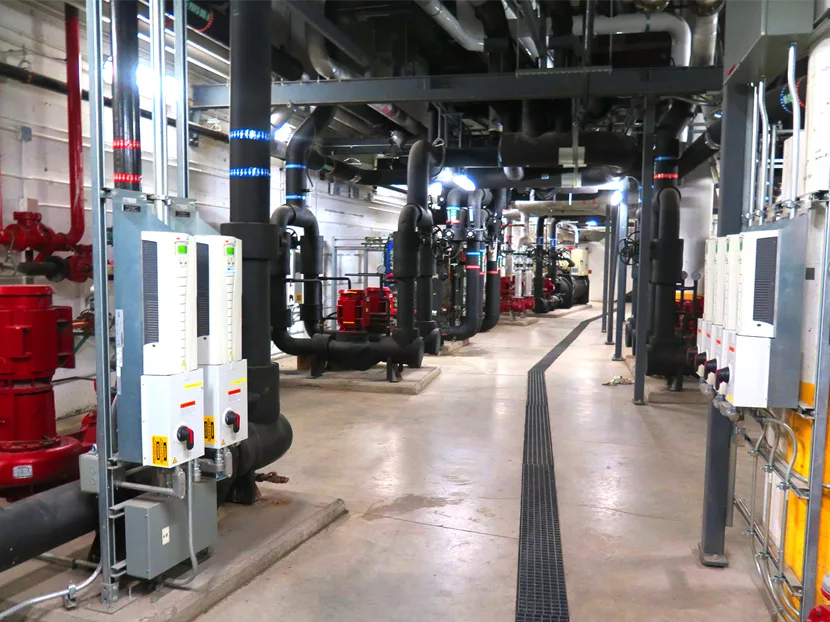After Hurricane Sandy and a wave of water smashed across Long Island in 2012 and shut down Adelphi University in Garden City for a week, the school’s management took a closer look at some of its infrastructure vulnerabilities. It was time to plan for greater resiliency and, as it happened, it was time for a wholesale upgrade to its aging district energy system.
Adelphi is a private university teaching arts, business and health sciences. It serves more than 5,000 undergraduate students, 2,500 graduate students and 1,000 faculty and staff. Its 75-acre Long Island campus is nestled tightly into an upscale residential community next to a golf course. The upgrade project included ambitious goals and formidable challenges. Through innovative modern approaches, the result met the demands of the situation and enhanced the quality of life on a 1.1-million-sq.-ft. campus. But it wasn’t easy.
The university is growing quickly and is a sustainability leader, with two LEED buildings, plus the Nexus building, which also would be LEED-certified. It did not yet exist when the project was designed. Adelphi employs geothermal technology, solar PV panels, sustainable construction practices, LED lighting and more.
The university wanted to continue the green theme and add resiliency. It needed a seamless upgrade that would be invisible to students, nearby residents and golfers next door, some self-sufficiency and energy savings to help with the business case.
HVAC engineers Martin Tremblay and Olivier Matte recommended replacing four old boilers and installing a 2-megawatt combined heat and power (CHP) plant. They also proposed a major upgrade of the ventilation system, with advanced controls to help optimize operations and enable some innovative energy approaches.
It would be challenging because CHP units can be noisy. How would they fit a 2-megawatt CHP through a 12-ft. by 17-ft. hatch? How would they fit the CHP, exhaust catalyst, silencer, pumps, air handling unit, two make-up fans and four new boilers into a 38-ft. by 60-ft. soundproofed underground mechanical room? The concrete ceiling had to be demolished, a new rigging system had to be brought in and many of the CHP components were redesigned to make it happen.
All this and their engineering firm, Ecosystem, had guaranteed $1.6 million in annual energy savings. This guarantee allowed Adelphi CFO Timothy Burton to pull off the project’s first innovation: a funding structure with yearly repayments totaling $1.2 million, converting a capital project into a revenue stream. To achieve the promised savings, the engineers would have to become innovative, too.
“We created a sealed mechanical enclosure to reduce the load and allow energy reclaim,” Tremblay said. “For example, we use the same fan for cooling and airflow and minimize the make-up air and parasitic load. Rather than adding a cooling tower to reject heat on a high-temperature loop, we installed cooling coils in the sound enclosure air exhaust system, taking advantage of the ventilation fans, along with intelligent controls to help optimize the associated functions.”
They also added variable-speed drives to modulate the fans. During winter when cooling air is colder, the fan speed is reduced. This shaves electricity peaks and reduces energy cost. The CHP’s electric power increase is 1.5 percent to 3.5 percent of the power generation, far below the 6 percent to 7 percent typical addition.
Intelligent system automation was also used to modify domestic water set points as a heat rejection strategy on very hot days and to modulate fume head valves in the science labs.
The effects of Sandy created a high level of management concern that as climate-change-related weather events continue to increase worldwide, the university has a responsibility to include these risks in its facility planning. During a Thanksgiving weekend, the team tested the resilience of the new system, disconnecting from the grid and bringing systems online, using CHP power. Everything worked within emergency–level assumptions, creating a high level of confidence in campus self-sufficiency.
The project has cut utility costs by 40 percent, payback on the improvements will be approximately eight years and the university’s greenhouse gas emissions were reduced by 4,645 metric tons per year.
A design-build approach, with guaranteed savings and state-of-the-art project planning, resulted in zero change orders during construction. Although this required greater time investment by university personnel, it was judged to be worthwhile, both economically and in terms of providing opportunities for ongoing project tweaks.
Biodome Intelligent Controls
It sometimes seems that while increasing the capability of systems and broadening the HVAC options available, intelligent controls are something of an invisible, unsung hero. One building that clarifies the advantage of easily managing complex zoning, sequencing, load shifting and modulation is an indoor zoo in Montreal, called the Biodome. It is home for 4,500 animals and 500 kinds of plants living in four different sets of climate conditions.
Before a recent system upgrade, the Biodome used steam heat and chilled water to keep a polar environment cold, a tropical rainforest hot, two other exhibit areas and common areas warm. There was no load shifting or energy recovery used.
Tests revealed a large underground aquifer about 60 ft. below the Biodome. This became an open-loop water-source system. The aquifer averages 61 F to 75 F. When the outside temperature is between 23 F and 32 F, the water-source system is not needed. Instead, energy is shifted among the four areas and pool temperatures are adjusted to match conditioning load requirements.
Now less-fresh make-up air is needed and more than 80 percent of heat energy is recovered and recirculated between zones. A 250-ton Trane RTWD electric heat pump cools the polar area, while two 450-ton Trane RTHD heat pumps provide heating (with an extra 450-ton for backup).
The water-source system supports both functions, acting as a heat sink in summer and heat source in winter.
“A 30-horsepower pump moves water from the underground aquifer to the heat exchangers at an average of 500 gpm through a 12-in. diameter pipe,” noted Jean Bouvrette, Biodome technical services director. “The daytime peak is about 1,000 gpm.”
Equipment control sequences are optimized and central controls are used to implement a peak demand strategy, using sensor data and calculations of the effects of pools as energy sinks, as well as energy time and location shifting. Heating and cooling are achieved using variable-speed pumps and fans, hydronic coils and heat recovery ventilators.
The beaver dam and salt-water tank are kept at about 48 F. Efficiencies are optimized by switching these systems on during the cooler night hours. This stores heat that can be used later during the peak demand daytime hours.
Each area is accurately conditioned for required loads, although it is sometimes efficient to vary from this slightly with help from the large volume pools.
“With only a one-degree temperature variation in the large pools, you can store a lot of heat or cooling, without affecting the living species,” Bouvrette explained. In this way, the underground aquifer is used for seasonal storage while the ponds are used for daily/nighttime energy storage.
The improvements have reduced energy costs by 52 percent or $980,000 each year. The project won awards from the Association of Energy Engineers and ASHRAE.
Spyders at School
After the main building at the Sycamore School in Indianapolis was expanded from 56,000 sq. ft. to 118,000 sq. ft., the old HVAC equipment began cooling the air faster than it could remove humidity. Levels were 80 percent or 90 percent most days and sometimes higher.
The school asked a series of HVAC professionals for advice but recommendations tended to be beyond the budget limitations of the institution. Finally, a local contractor recommended a new Honeywell product called the Spyder. It’s described as being an “economical unitary controller that is limitless in the amount of programmability it offers.
DEEM Energy installed four PVL6436A Spyders and one PUL6438 on a rooftop unit to control four zones. The team also installed a WEB-403-AX controller and eight D2 Series zone dampers to help manage conditions in different parts of the building. The compressor’s run time was increased without overcooling the building and the need for a dual-bulb thermostat was eliminated by using four T7770C1002 wall modules.
The solution cost about half as much as some of the other suggestions and humidity levels now range from 50 percent to 60 percent. The school is considering adding the same technology to other buildings on the campus.
Passive House Apartments with Minimal Controls
Whether for extending the life of old equipment, enabling the newest clean district energy plants, or keeping penguins alive in an indoor zoo, advanced controls can provide a contemporary path to energy savings, better comfort and reduced carbon emissions. However, there are some very leading-edge projects where simple controls are preferred.
“I’m somewhat anti-controls,” said Sarah Carter, a project manager at Petersen Engineering in Portsmouth, N.H. “They seldom work, especially in our projects.”
Carter’s company specializes in some of the newest approaches to affordable multifamily housing.
The Distillery North Apartments in Boston is a 28-unit retrofit of an old factory building. Carter’s company has upgraded it to the passive house standard. It has very thick walls, triple-pane windows, solar photovoltaic panels on the roof and a P-Series Mitsubishi air-source heat pump in each unit, along with a dedicated thermostat and a heat recovery ventilator.
Carter noted that the loads are greatly reduced in a passive house building and much of today’s HVAC equipment offered in preset sizes would be oversized, especially for one-bedroom and two-bedroom apartments.
When they started the project, they decided to prove the model, increasing the efficiency of the thermal envelope and testing the equipment for two years in just a few of the apartments.
They learned very quickly how well it worked and completed the retrofit for the entire building. The owner reports that, thanks to the solar panels on the roof, superior envelope and minimized mechanicals, residents pay about $65 per year for heating and cooling.
“We like to keep things simple,” Carter said.
Now they are planning a similar 37-unit project next door.





